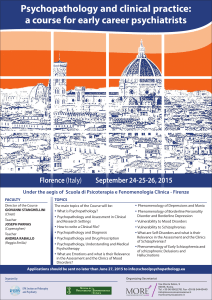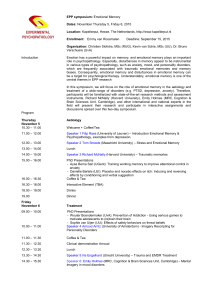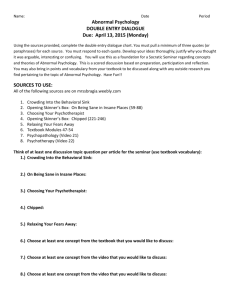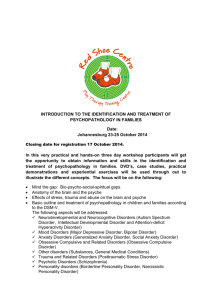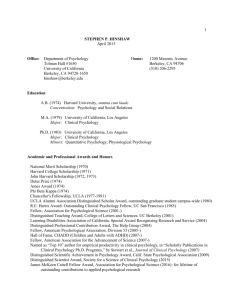Child and Adolescent Psychopathology
advertisement
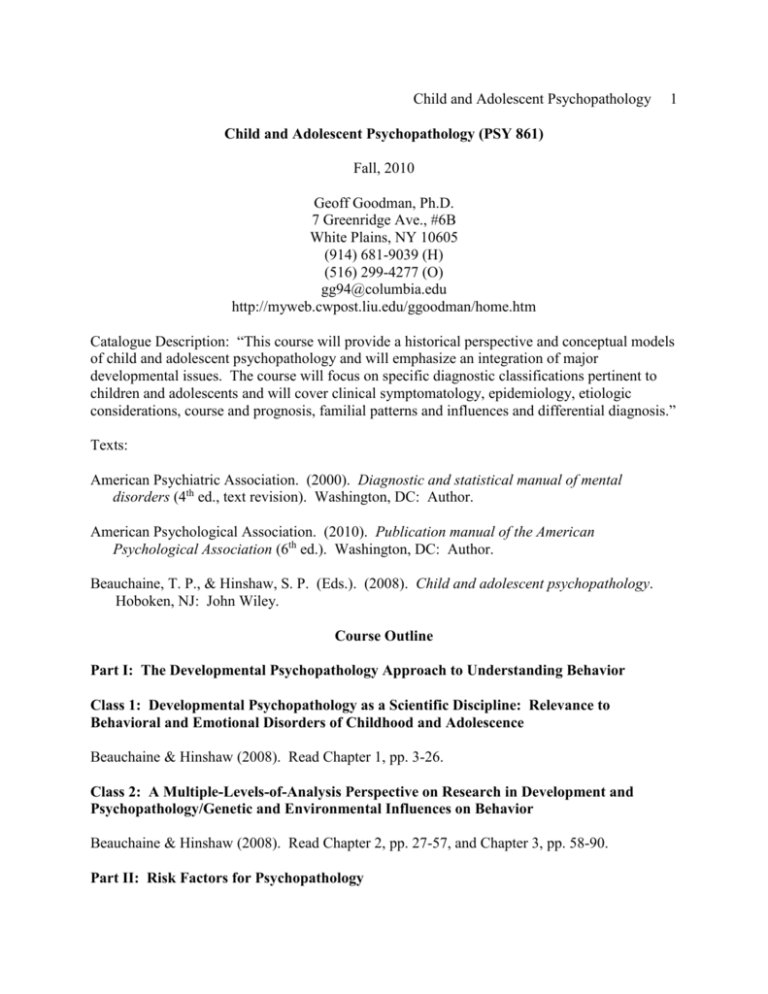
Child and Adolescent Psychopathology 1 Child and Adolescent Psychopathology (PSY 861) Fall, 2010 Geoff Goodman, Ph.D. 7 Greenridge Ave., #6B White Plains, NY 10605 (914) 681-9039 (H) (516) 299-4277 (O) gg94@columbia.edu http://myweb.cwpost.liu.edu/ggoodman/home.htm Catalogue Description: “This course will provide a historical perspective and conceptual models of child and adolescent psychopathology and will emphasize an integration of major developmental issues. The course will focus on specific diagnostic classifications pertinent to children and adolescents and will cover clinical symptomatology, epidemiology, etiologic considerations, course and prognosis, familial patterns and influences and differential diagnosis.” Texts: American Psychiatric Association. (2000). Diagnostic and statistical manual of mental disorders (4th ed., text revision). Washington, DC: Author. American Psychological Association. (2010). Publication manual of the American Psychological Association (6th ed.). Washington, DC: Author. Beauchaine, T. P., & Hinshaw, S. P. (Eds.). (2008). Child and adolescent psychopathology. Hoboken, NJ: John Wiley. Course Outline Part I: The Developmental Psychopathology Approach to Understanding Behavior Class 1: Developmental Psychopathology as a Scientific Discipline: Relevance to Behavioral and Emotional Disorders of Childhood and Adolescence Beauchaine & Hinshaw (2008). Read Chapter 1, pp. 3-26. Class 2: A Multiple-Levels-of-Analysis Perspective on Research in Development and Psychopathology/Genetic and Environmental Influences on Behavior Beauchaine & Hinshaw (2008). Read Chapter 2, pp. 27-57, and Chapter 3, pp. 58-90. Part II: Risk Factors for Psychopathology Child and Adolescent Psychopathology 2 Class 3: Child Maltreatment: A Neurodevelopmental Perspective on the Role of Trauma and Neglect in Psychopathology Beauchaine & Hinshaw (2008). Read Chapter 4, pp. 93-128. Class 4: Impulsivity and Vulnerability to Psychopathology/Behavioral Inhibition as a Risk Factor for Psychopathology Beauchaine & Hinshaw (2008). Read Chapter 5, pp. 129-156, and Chapter 6, pp. 157-179. Class 5: Exposure to Teratogenic Agents as a Risk Factor for Psychopathology/Brain Injury as a Risk Factor for Psychopathology Beauchaine & Hinshaw (2008). Read Chapter 7, pp. 180-207, and Chapter 8, pp. 208-233. Class 6: Affective Style and Risk for Psychopathology/Emotion Dysregulation as a Risk Factor for Psychopathology Beauchaine & Hinshaw (2008). Read Chapter 9, pp. 234-264, and Chapter 10, pp. 265-298. Part III: Externalizing Behavior Disorders Class 7: Attention-Deficit/Hyperactivity Disorder/Oppositional Defiant Disorder, Conduct Disorder, and Juvenile Delinquency Beauchaine & Hinshaw (2008). Read Chapter 11, pp. 301-334, and Chapter 12, pp. 335-369. DSM-IV. (2000). Skim pp. 85-103. Class 8: Antisocial Personality Development/Prevalence of Alcohol and Drug Involvement During Childhood and Adolescence Beauchaine & Hinshaw (2008). Read Chapter 13, pp. 370-404, and Chapter 14, pp. 405-444. Part IV: Internalizing Behavior Disorders Class 9: Anxiety Disorders/Depressive Disorders Beauchaine & Hinshaw (2008). Read Chapter 15, pp. 447-476, and Chapter 16, pp. 477-509. DSM-IV. (2000). Skim pp. 108-134. Class 10: The Development of Borderline Personality Disorder and Self-Injurious Child and Adolescent Psychopathology 3 Behavior Beauchaine & Hinshaw (2008). Read Chapter 17, pp. 510-539. Part V: Other Psychological Disorders Class 11: Bipolar Disorder/Autism Spectrum Disorders: A Developmental Perspective Beauchaine & Hinshaw (2008). Read Chapter 18, pp. 543-574, and Chapter 19, pp. 575-613. DSM-IV. (2000). Skim pp. 39-84. Class 12: Childhood Schizophrenia/Eating Disorders Beauchaine & Hinshaw (2008). Read Chapter 20, pp. 614-642, and Chapter 21, pp. 643-669. DSM-IV. (2000). Skim pp. 103-108. Class 13: Class Presentations Class 14: Class Presentations Course Requirements A. Using one particular theoretical or empirical perspective discussed in the readings, write a paper exploring a contemporary social issue that could affect the emotional well-being of children (e.g., gun violence, HIV, poverty, the expanding number of juvenile detention centers, the Internet, computer games, unlicensed childcare, gangs, hate crimes). What implications does the theoretical or empirical perspective have for both understanding and redressing this issue? Feel free to be imaginative. Maximum number of doublespaced pages: 10. Please use APA Publication Manual format. The paper is due at the beginning of Class 9. Fifty percent of final grade. B. Develop a research proposal for a study on some aspect of child or adolescent psychopathology. The proposal needs to include a brief review of the relevant theoretical and empirical literature; a clear exposition of the hypotheses to be tested; descriptions of the subject population, measures, procedures, and data analytic strategies to be used; and the implications of the proposed study for that particular area of research, assuming first significant findings, then nonsignificant findings. Maximum number of double-spaced pages: 10. Please use APA Publication Manual format. The research proposal is due at the beginning of Class 13. Each person will make a 10-minute presentation of her or his paper during Class 13 or Class 14. Brief group discussion will follow each presentation. Order of presentation will be alphabetical. Fifty percent of final grade. Child and Adolescent Psychopathology 4 Academic Competencies 1) Students will be able to explain what “developmental psychopathology” is and how it relates to symptom formation and the underlying psychic structures that contribute to it. 2) Students will be able to explain the conceptual differences between “patterns of maladaptation” and “patterns of symptomatology”. 3) Students will be able to provide examples of similar symptomatic patterns that reflect distinctly different patterns of maladaptation and provide reasons why a child might be manifesting a particular pattern of symptoms (e.g., current psychosocial stressor, historical precedents [e.g., chronic parental emotional unresponsiveness, chronic marital discord], neurodevelopmental complications). 4) Students will be able to discuss the manifestation of symptoms from a variety of theoretical perspectives. 5) Students will be able to discuss the conceptual differences between an organismic/psychoanalytic model of child psychopathology and a systems/behavioral model of child psychopathology. 6) Students will become familiar with the child and adolescent psychiatric diagnoses listed in the DSM-IV (American Psychiatric Association, 2000) as well as the other diagnoses known to manifest in children and adolescents. 7) Students will become familiar with the limitations of categorical diagnostic classification systems such as the DSM-IV and their obscuring of conceptual ambiguity and deeper levels of psychic meaning. Diversity 1) Students will be able to understand both traditional and feminist interpretations child development and the wide-ranging clinical and social implications for gender roles, division of labor among families, dominance-submission paradigms and the impact on family violence, and sexual orientation. 2) Students will be able to discuss child and adolescent psychopathology from non-Western cultural perspectives. 3) Students will be able to discuss child and adolescent psychopathology from more explicitly sociological perspectives. Ethics Child and Adolescent Psychopathology 5 1) Students will explore child and adolescent psychopathology with an attitude of openness, understanding, and nonjudgment. 2) Students will complete their course assignments honestly and independently of others. Professional Development 1) Students will contact me prior to class if they cannot attend or will be late. 2) Students will make a good-faith effort to complete the assigned readings on time and participate in class discussions. 3) Students will prepare their writing assignments on time--applying both diligence and a viable conceptual organization--and follow the Publication Manual of the American Psychological Association for formatting. 4) Students will prepare creative and poignant class presentations. From Clinical Psychology Doctoral Program Student Handbook 2007-2008 The grades and definitions listed below are used in doctoral courses: A work is excellent; student not only demonstrates high achievement but also superior intellectual initiative beyond the objectives of the course; superior test performance; consistent superior performance across all work and tests.” A- Work is excellent; student demonstrates either high achievement (by going beyond the requisites of the course) or surpasses expectations for a student at this level; clearly demonstrates knowledge and competence beyond course requirements. B+ Work is very good; student demonstrates clear understanding of the material and work is generally proficient and relatively free of errors; very good test performance. B Work is acceptable; student has applied requisite understanding of the material; acceptable test performance. B- Work is acceptable but lacking precision or understanding of the material; below average test performance. F Work is unacceptable for a graduate student; work errors greatly exceed those of the class, student has not effectively applied knowledge at this level from readings, class; poor performance on tests. Course must be repeated. INC Work which, as far as it has progressed, is of B or higher quality, but is incomplete because of illness, accident, or other serious extenuating circumstances. All incompletes must be completed before the end of the next semester or the grade will automatically be changed to an F. From the Graduate Bulletin (2003-2005, p. 15), “Academic Irregularities”: “In the case of a minor infraction that is the student’s first disciplinary offense, the Dean may authorize the faculty member to dispose of the charges, limiting the maximum penalty to failure in the Child and Adolescent Psychopathology 6 course….In the case of a major infraction, or in the case of repeat academic offenses, the student may be subject to suspension or expulsion from the campus.”
